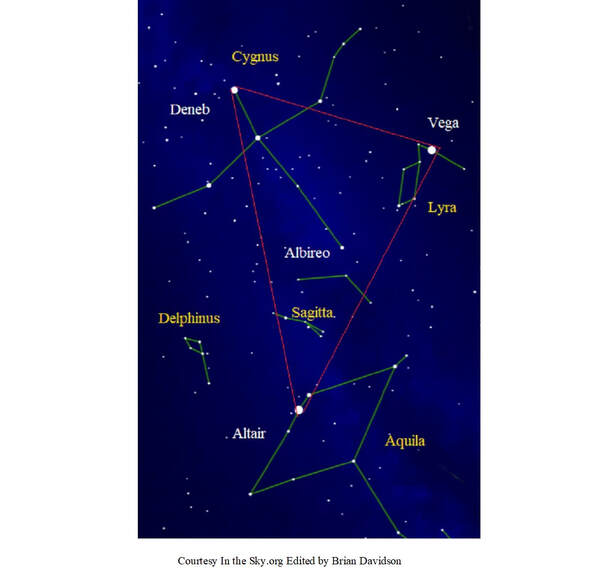|
Although the summer solstice is past you still have to stay up late to get the benefits of a dark sky. June provided plenty of clear nights but unfortunately clouded over for the combination of a crescent Moon, Venus and Mars togetther on the 22nd June. However the sky was clear later in the month to see The Moon and Mars fairly close. Observing The following chart represents the night sky at 11.00pm BST on the 8th of Jul and at 10.00pm BST on the 23rd July. To use the chart, face south at the appropriate time with the bottom of the chart towards the horizon and you will see the stars in the chart. At this time of year it is necessary to stay up later to get reasonable darkness but don’t worry as you will be able to see the stars in this month’s chart for some time to come. We shall focus on the jewel of the summer sky this month- The Summer Triangle. It is not a constellation but an asterism formed by three bright stars from three separate constellations. Facing south and looking up just before your zenith you will see a very bright star. (You might want to get your deckchair out so that you can lie on your back.) This star is Vega and you cannot miss it because of its brilliance, at magnitude 0, the third brightest star visible from the northern hemisphere. It has a grouping of four fairly faint stars to its bottom left hand side and together these stars make up the constellation Lyra- The Lyre or Harp. Vega is relatively close to the Earth at a distance of only 25 light years. It lies on the edge of the Milky Way represented by the lighter shading in the chart. To the left of Lyra in the brighter region of the Milky Way you will find a giant cross and this is the constellation Cygnus- The Swan. The bright star Deneb represents the tail of the swan which is flying down the Milky Way. Deneb is a supergiant and at magnitude 1.3 it is outshone by Vega because it is much further from Earth at a distance of 1,500 light year. Cygnus is a lovely clear signpost high in the sky and the star Albireo, a beautiful double star when viewed through a telescope, represents the beak of the swan. Now from a line joining Deneb and Vega, look down about halfway to the horizon and you will find another bright star, Altair, in the constellation Aquila- The Eagle. Altair is the eighth brightest star visible from the northern hemisphere and at magnitude 0.8 it outshines Deneb because it is so close to the Earth at only 17 light years away. The three stars Vega, Deneb and Altair form what is called the Summer Triangle depicted in red on the chart. You will enjoy looking at it for the rest of the summer and it is a great help in finding your way around the night sky.
In fact we can use it straight away to find the other two constellations mentioned on the chart. Contained within the Summer Triangle near the bottom vertex is the constellation Sagitta- The Arrow. It is the third smallest constellation and is somewhat dart shaped but its brightest star is only magnitude 3.5 so a dark sky and clear conditions are required. To the left of Sagitta and outside the Summer Triangle is another small constellation Delphinus- The Dolphin. It has a distinctive shape but again its stars are of a similar magnitude to those of Sagitta. Something to look out for Venus has been prominent in the evening sky just after sunset for some time now but it will be at its brightest on Sunday the 9th. Some of you may be wondering why this is the case as it was at dichotomy on the 4th June. The brightness of Venus depends on both its phase and its distance from the Earth and it so happens that although it is in more of a crescent phase it is also closer and for a short time it will be at maximum brightness before it reaches inferior conjunction and no longer visible. On Friday the 21st July there will be a close approach of the Moon and Mars visible just after sunset but don’t wait too late as they both set fairly quickly afterwards. Clear skies.
0 Comments
Leave a Reply. |
AuthorWMA members Archives
July 2024
Categories |
Proudly powered by Weebly


 RSS Feed
RSS Feed